How To Start A Stihl Chainsaw: Step By Step Guide
- January 25, 2024
- 0 comment
Starting a STIHL chainsaw is a task that demands precision and a strict adherence to safety protocols, ensuring both the efficient operation of the machinery and the operator’s safety. In this detailed guide, we delve into the intricacies of utilizing the STIHL Master Control lever, implementing proper starting techniques, and following crucial warm-up procedures. Our aim is to facilitate a seamless start-up process, significantly reducing the likelihood of equipment damage and enhancing user confidence. Whether you’re a seasoned professional or a first-time user, this comprehensive manual offers invaluable insights into getting your STIHL chainsaw up and running with ease and efficiency.
List on How To Start A Stihl Chainsaw
- Step 1: Engage the Chain Brake for Safety
- Step 2: Use the Purge Pump for Easy Fuel Priming
- Step 3: Activate the Decompression Valve for Easy Starting
- Step 4: Set the Master Control Lever to the Correct Start Position
- Step 5: Pull the Starter Rope with the Right Technique
- Step 6: Managing the Engine’s First Fire (Burp)
- Step 7: Follow the Post-Start Procedure for Smooth Operation
Understanding Your Chainsaw’s Controls
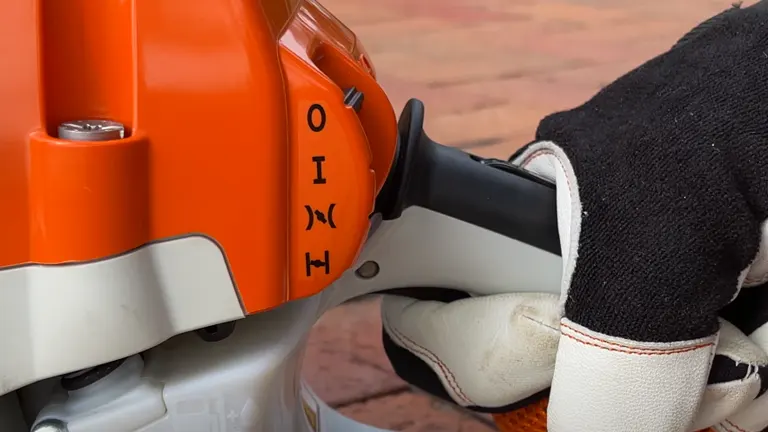
Before you initiate the start-up process, familiarize yourself with the Master Control lever’s symbols and positions:
Cold Start Position: How to Prepare Your Chainsaw for First-Time Use
Essential when beginning the operation of your STIHL chainsaw from a completely inactive state. It’s particularly pertinent when the engine is cold, which typically means it hasn’t been run recently or has cooled down after previous use. This position is also crucial if your chainsaw’s engine has stopped due to running out of fuel, as it primes the engine for a fresh start. When selected, this position adjusts the chainsaw’s internal mechanisms, such as the choke, enriching the fuel mixture delivered to the engine. This enriched mixture is necessary to initiate the combustion process in a cold engine, ensuring a smoother start.
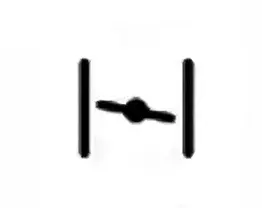
Warm Start Position: How to Restart a Warm Chainsaw
Designed for situations where the chainsaw’s engine is not entirely cold but might need some assistance to get going again. This could be shortly after the engine has been in operation and is still warm, or when you notice the engine is trying to start (often recognizable by specific sounds or partial engagement). This position fine-tunes the fuel mixture and air intake to suit an engine that’s not as cold and doesn’t require the full assistance of the cold start setting. It’s a midway point that helps in restarting the engine without over-flooding it with fuel, ensuring a balance for optimal restart performance.

Run Position: Maintaining Optimal Chainsaw Performance
Where you’ll have the lever most of the time during the operation of your STIHL chainsaw. Once the chainsaw has been started successfully, shifting to this position allows you to operate the chainsaw under normal conditions. Whether you’re cutting, trimming, or performing any other task, this position ensures that the chainsaw delivers consistent and stable performance. It maintains a standard fuel-to-air ratio, suitable for the engine to run efficiently while you’re working. It’s the go-to setting for regular chainsaw operation, ensuring the engine runs smoothly and responds correctly to your input.

Off Position: Safely Turning Off Your Chainsaw
The safety anchor of your chainsaw’s operations. When you’re done with your tasks, or if you need to safely stop the chainsaw for any reason, shifting the Master Control Lever to this position will shut down the engine. It effectively disables the chainsaw’s ignition system, ensuring that the engine stops running and the chainsaw ceases operation. This position is crucial for safe handling, transport, or storage of your chainsaw, preventing accidental starts or undesired operation. It’s a fundamental safety feature that provides peace of mind, ensuring that the chainsaw remains inactive when not in use.

Note that the exact location of the STIHL Master Control lever and its symbols may vary slightly by model. If your chainsaw looks different from the standard, refer to your product-specific instruction manual for detailed guidance.
Essential Pre-Start Safety Checks for Your STIHL Chainsaw
Before you initiate the start-up of your STIHL chainsaw, conducting a series of safety checks is imperative. These checks are designed to ensure not just the smooth operation of your chainsaw but also your safety and the safety of those around you. Here are the key pre-start safety checks you should always perform:
Step 1: Inspect Fuel and Oil Caps
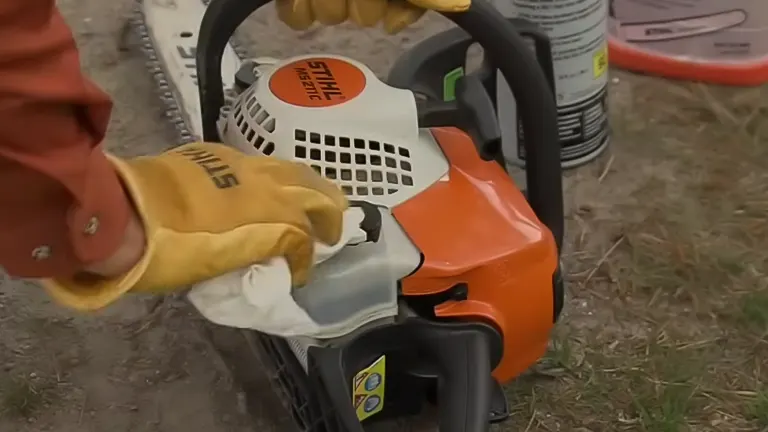
The first step is to check the fuel and oil caps on your chainsaw. Ensure that these caps are tightened securely. A loose cap can lead to fuel or oil leakage, which not only wastes these fluids but can also pose serious safety hazards. After securing the caps, inspect the chainsaw for any spilled fuel or oil. If you find any, clean it up thoroughly. This prevents the risk of fire and ensures that your working environment is safe.
Step 2: Examine Your Chainsaw for Damage or Wear
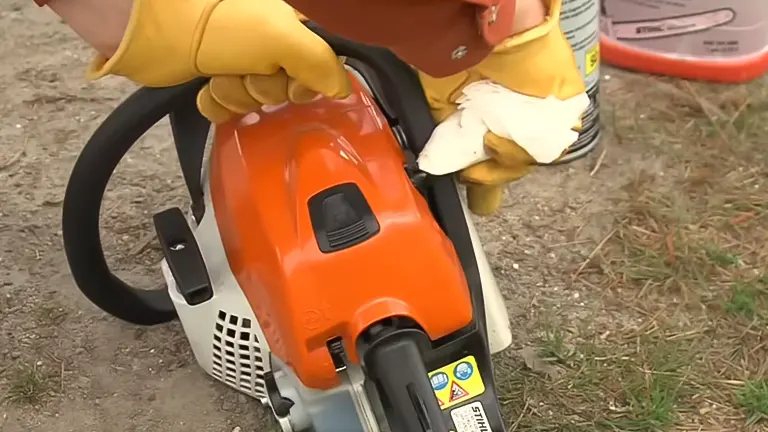
A thorough examination of the chainsaw is crucial before starting it. Check every part of the chainsaw to make sure everything is intact. Pay close attention to ensure that no parts are broken, missing, or showing signs of wear. This includes the chain, the bar, the handles, and any safety guards or devices. A well-maintained chainsaw not only operates more efficiently but also significantly reduces the risk of accidents.
Step 3: Maintain a Safe Distance from the Refueling Area
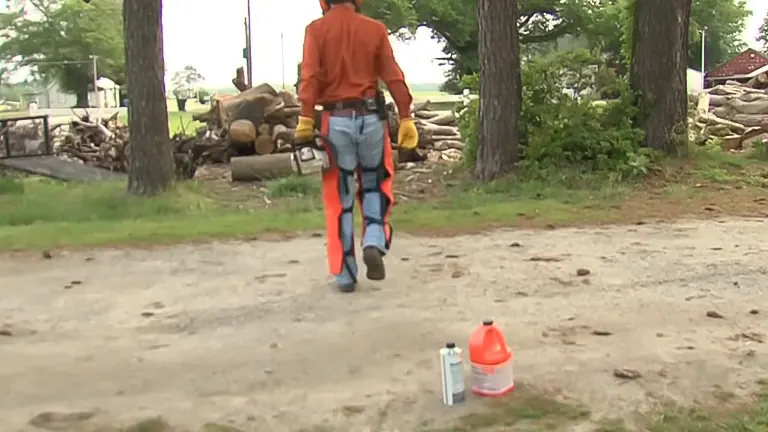
When you’re ready to start your chainsaw, remember to maintain a safe distance from the fueling area. It’s recommended to start gas-powered tools at least 10 feet away from where you’ve refueled them. This precaution is to prevent any accidental ignition of fuel vapors, ensuring your safety and that of your surroundings.
Step 4: Wear Protective Gear Before Starting
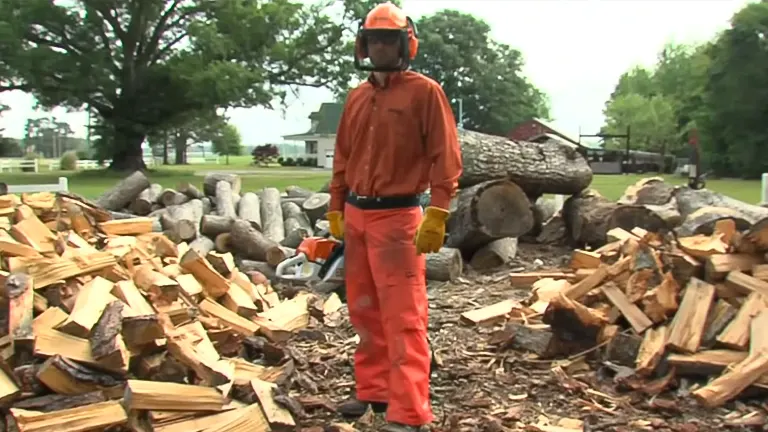
Personal protective equipment is non-negotiable when operating a chainsaw. Before starting your STIHL chainsaw, ensure you are adequately equipped with safety boots, chaps, gloves, safety glasses, hearing protection, and a helmet system. Each piece of gear is designed to provide specific protection, from shielding your eyes from debris to protecting your legs from accidental cuts.
Step 5: Prepare for Interruptions During Chainsaw Operation
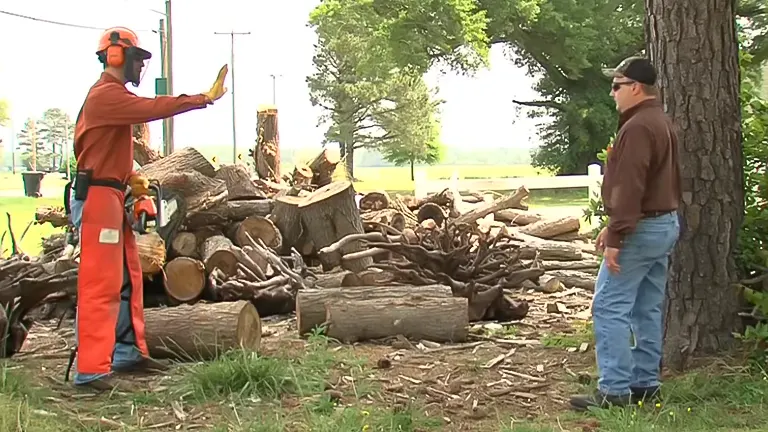
In the event that you are approached or need to address something while the chainsaw is running, it’s crucial to know how to handle the situation safely. Always engage the chain brake first, which stops the chain from moving. Then, shut off the engine before addressing any interruptions. This ensures that the chainsaw won’t cause harm to you or anyone else if it’s accidentally bumped or mishandled during the interruption.
Starting Procedures: How to Start Your Chainsaw Safely
Ground Starting Position: The Safest Way to Start Your Chainsaw
- Place it on a clear, flat area ensuring the bar and chain are free of obstructions.
- Slip the toe of your right foot into the rear handle, press down on the front handle with your left hand (thumb and fingers fully wrapped around it), and lock your elbow.
- Your right hand should grip the starter handle for pulling the rope. This position is safe and recommended when you’re in a clear open area.

Standing Starting Position: Alternative Method for Starting in Tight Spaces
- Place the rear handle of the saw between your legs, just above the knees.
- Grip the front handle with your left hand (thumb and fingers fully wrapped around it) and keep your left arm locked.
- Use your right hand to start the saw. This method is advisable when you’re not in a clear area and need to avoid twigs, brush, or debris.
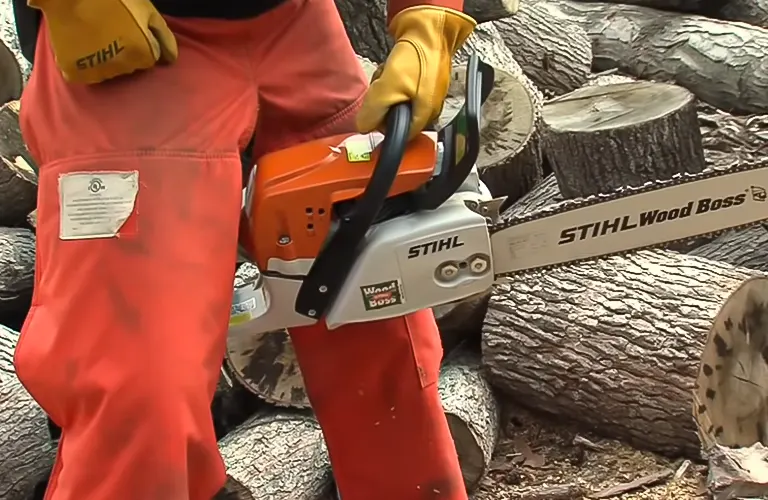
How to Warm-Up a STIHL Chainsaw
To ensure a smooth start and proper functioning of your STIHL chainsaw, it’s essential to follow the correct procedures for engaging the starting controls and performing the warm-up steps. Each step is designed to prepare the chainsaw’s engine and mechanisms for safe and efficient operation. Here’s a detailed breakdown of each step:
Step 1: Engage the Chain Brake for Safety
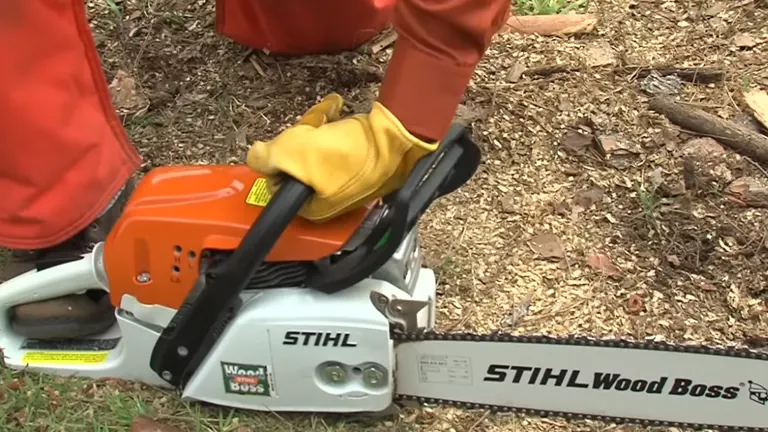
Before initiating the start-up process, it’s crucial to engage the chain brake. This safety feature locks the chain in place, preventing it from moving during the start-up process. Engaging the chain brake minimizes the risk of accidental injury from the chain moving unexpectedly.
Step 2: Use the Purge Pump for Easy Fuel Priming (if available)
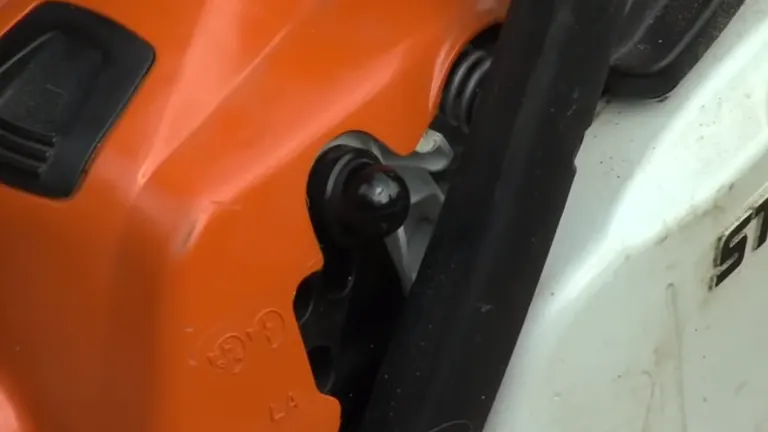
If your STIHL chainsaw is equipped with a purge pump feature, make use of it before starting the engine. Press the bulb a minimum of five times. This action draws fuel into the carburetor and circulates it back to the fuel tank, helping to prime the engine without flooding it with excess fuel.
Step 3: Activate the Decompression Valve for Easy Starting (if available)
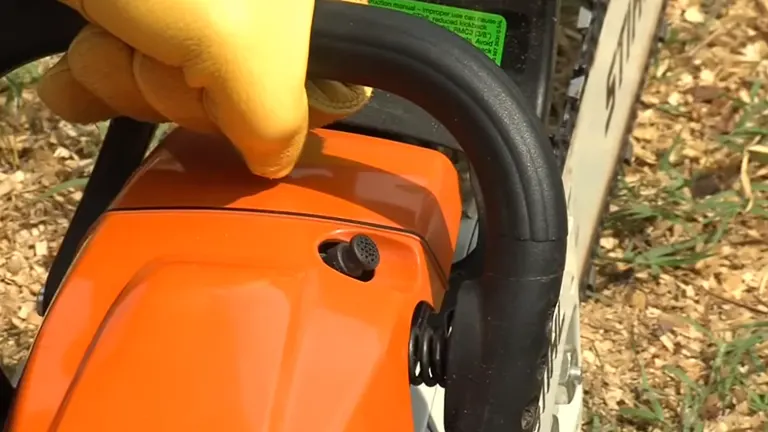
For those using professional models equipped with a decompression valve, press this valve in before starting. This feature reduces the compression in the engine during the start-up process, making it easier to pull the starter rope and reducing the effort required to start the engine.
Step 4: Set the Master Control Lever to the Correct Start Position
The position of the Master Control Lever is crucial for starting the engine:
- For Cold Starts: Grip the rear handle firmly, depress the throttle trigger interlock, and squeeze the throttle trigger. Then, move the Master Control Lever to the cold start position. This setting adjusts the engine to optimal conditions for starting when the engine is cold.
- For Warm Starts: If the chainsaw was recently running and the engine is still warm, or after the chainsaw has fired, set the Master Control Lever to the warm start position. This setting is tailored for engines that don’t require the full choke used during a cold start.
Step 5: Pull the Starter Rope with the Right Technique
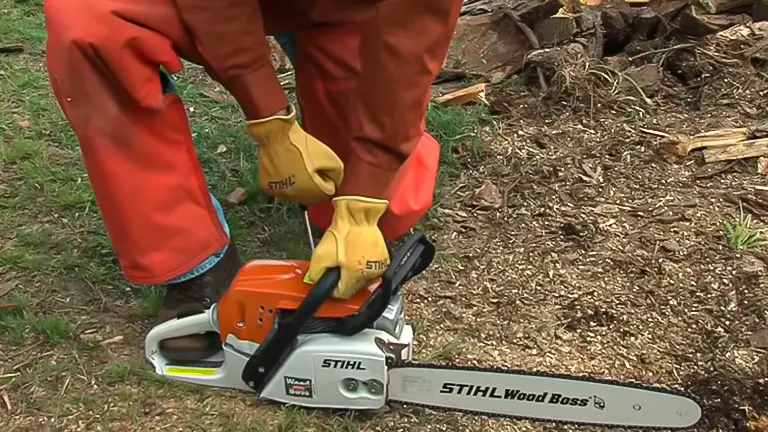
Gently pull the starter rope until you feel a slight resistance. At this point, provide a sharp, brisk pull and then guide the rope back into the starter housing slowly. This action should be smooth and controlled to avoid damaging the starter mechanism.
Step 6: Managing the Engine’s First Fire (Burp)

When you hear the chainsaw engine attempt to start (a “burp”), it’s time to adjust the Master Control Lever to the warm start position if it was in the cold start position. If your model has a decompression valve, press it again. Then, continue to pull the starter rope until the engine starts.
Step 7: Follow the Post-Start Procedure for Smooth Operation
Once the engine starts:
- Release the Chain Brake: This allows the chain to move freely.
- Warm Up the Engine: Briefly accelerate the chainsaw a few times. This step ensures that the engine reaches a suitable operating temperature and that the lubrication is distributed throughout the engine and the chain.
- Re-engage the Chain Brake: Do this before you move into your cutting position. It’s a safety precaution to ensure the chain doesn’t move as you position yourself and the chainsaw for work.
How to Stop Your Chainsaw and Fix a Flooded STIHL Engine
Turning off your chainsaw is a breeze! Just flick the master control lever to ‘off’ with your right thumb. Remember to keep a firm grip on the front handle with your left hand.
Reviving a Flooded Engine:
Got a flooded engine? No worries, here’s a snappy fix:
- Switch Off: Dial the master control lever to ‘off’ to halt fuel flow.
- Plug Play: Whip off the spark plug boot, unscrew the spark plug, and give it a good wipe to dry.
- Crank it Out: Yank the starter rope a few times to shoo away the pesky excess fuel.
- Snap it Back: Reinstall the spark plug and boot with a click.
- Step Back: Take a 10-ft stroll away (safety first!).
- Warm-Up Mode: Twist the lever to ‘warm start’, then give the starter rope a confident pull.
Simplifying Chainsaw Start-Up with STIHL Easy2Start and STIHL ElastoStart
When you’re in the market for a new chainsaw, the options can be overwhelming. But if you’re eyeing a STIHL chainsaw, you’re already on the right path. STIHL chainsaws are not just tools; they are a blend of power, performance, and cutting-edge technology. Among their lineup, two features that you should definitely consider are the STIHL Easy2Start and STIHL ElastoStart systems. Here’s why they are worth your attention:
STIHL Easy2Start: Effortless Starting with Reduced Effort
Starting a chainsaw can sometimes feel like a mini workout, but not with STIHL Easy2Start. This system is a game-changer for anyone who’s faced the tug-of-war with a chainsaw’s pull cord. It significantly reduces the force you need to apply to start the engine. This means you can say goodbye to the strenuous pull-starts and instead enjoy a gentle and effortless start-up. It’s not just easy; it’s Easy2Start!

STIHL ElastoStart: Smooth Pulls for Comfortable Start-Ups
Imagine the jolt you feel when the chainsaw roars to life. That’s where STIHL ElastoStart comes into play. This ingenious feature includes a specially designed shock-absorbing grip. It effectively smooths out the peak forces you typically encounter during the start-up process. The result? A significantly more comfortable experience. No more harsh snaps or jolts, just a smooth, steady pull until your chainsaw purrs into action.

By meticulously following these steps and understanding your STIHL chainsaw’s control features, you can start your equipment safely and efficiently, ensuring a smooth operation and extending the life of your tool. Remember, proper handling and regular maintenance are crucial for the optimal performance and longevity of your chainsaw.
Related Articles:
- Why Were Chainsaws Invented?
- Untangling and Installing a Chainsaw Chain: A Step-by-Step Guide
- Best Chainsaw Bar and Chain Oil
- How to Split Log with a Pocket Chainsaw
- Bow Saw Chainsaw Review
- The Dangers of Misusing a Chainsaw: A Warning Against Cold Seizures
- Chainsaw Kickback: Causes, Dangers, and Safety Tips
- Types of Chainsaw Chains and How to Choose
- How Tight Should A Chainsaw Chain Be
FAQs
- I’m a first-time STIHL chainsaw user. What’s the first thing I should learn before turning it on?
Welcome to the STIHL family! The first thing you should learn is the importance of safety. Familiarize yourself with the chainsaw’s safety features, read the user manual thoroughly, and always wear appropriate protective gear, including gloves, goggles, and ear protection. - How does the weather affect my STIHL chainsaw’s performance?
Weather can be a big factor. In colder climates, your chainsaw may take longer to start, and the oil might thicken, affecting lubrication. In very hot weather, the engine can overheat. Always adjust your maintenance routine to suit the weather conditions and store your chainsaw in a dry, safe place. - Can I use any brand of chain oil with my STIHL chainsaw, or should I stick to STIHL products?
While STIHL chain oils are specifically designed to complement the performance and longevity of their chainsaws, you can use other brands. However, ensure that the oil is of high quality and suitable for the specific model of your chainsaw. - How often should I sharpen the chain, and can I do it myself?
The frequency of sharpening depends on your usage. If you notice the chainsaw is not cutting as efficiently or the sawdust resembles fine powder instead of small chips, it’s time to sharpen the chain. You can do it yourself with the right tools and knowledge, or you can have it professionally done for the best results. - I’ve heard mixed opinions about using ethanol-blended fuels. Is it safe for my STIHL chainsaw?
STIHL recommends using high-quality, ethanol-free gasoline for optimal performance and engine longevity. If you must use ethanol-blended fuel, never use fuel with more than 10% ethanol (E10), and ensure it’s fresh and stored properly. - What’s the best way to store my STIHL chainsaw during the off-season?
Proper off-season storage is crucial. Clean the chainsaw thoroughly, drain or stabilize the fuel, lubricate the chain, and store it in a dry, secure place. Remove the chain and bar, if possible, and protect the cutting edge. Consult your user manual for model-specific instructions. - Is it normal for my chainsaw to emit smoke during operation?
A small amount of smoke at startup can be normal, especially if the chainsaw is cold. However, excessive or continuous smoke might indicate an issue, such as an overly rich fuel mixture, incorrect oil-to-fuel ratio, or a dirty air filter. If in doubt, consult a professional.
Join the discussion below by sharing your experiences, tips, or reviews. Your contributions help others make informed decisions and navigate their chainsaw choices with confidence. Let’s build a community of shared knowledge for all wood-cutting enthusiasts!

David Murray
Forestry AuthorI'm David Murry, a forestry equipment specialist with a focus on chainsaw operation. With over 13 years of experience, I've honed my skills in operating and maintaining a wide range of machinery, from chainsaws to log splitters. My passion for the outdoors and commitment to sustainable forestry drive my work, which emphasizes safety, efficiency, and staying updated with industry advancements. Additionally, I'm dedicated to sharing my expertise and promoting environmental awareness within the forestry community.







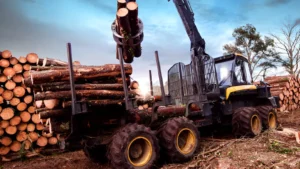

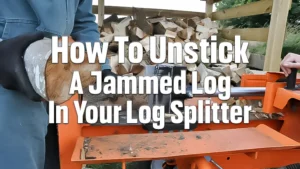


Leave your comment